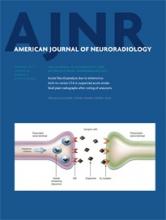Research ArticleNeurointervention
Parent Artery Curvature Influences Inflow Zone Location of Unruptured Sidewall Internal Carotid Artery Aneurysms
K. Futami, H. Sano, T. Kitabayashi, K. Misaki, M. Nakada, N. Uchiyama and F. Ueda
American Journal of Neuroradiology February 2015, 36 (2) 342-348; DOI: https://doi.org/10.3174/ajnr.A4122
K. Futami
aFrom the Department of Neurosurgery (K.F.), Mattoh-Ishikawa Central Hospital, Ishikawa, Japan
H. Sano
bDepartments of Neurosurgery (H.S., T.K., K.M., M.N., N.U.)
T. Kitabayashi
bDepartments of Neurosurgery (H.S., T.K., K.M., M.N., N.U.)
K. Misaki
bDepartments of Neurosurgery (H.S., T.K., K.M., M.N., N.U.)
M. Nakada
bDepartments of Neurosurgery (H.S., T.K., K.M., M.N., N.U.)
N. Uchiyama
bDepartments of Neurosurgery (H.S., T.K., K.M., M.N., N.U.)
F. Ueda
cRadiology (F.U.), Kanazawa University School of Medicine, Ishikawa, Japan.

REFERENCES
- 1.↵
- Strother CM,
- Graves VB,
- Rappe A
- 2.↵
- 3.↵
- Liou TM,
- Liou SN
- 4.↵
- Hoi Y,
- Meng H,
- Woodward SH, et al
- 5.↵
- Liou TM,
- Chang WC,
- Liao CC
- 6.↵
- Hassan T,
- Timofeev EV,
- Saito T, et al
- 7.↵
- Cebral JR,
- Sheridan M,
- Putman CM
- 8.↵
- 9.↵
- Gonzalez CF,
- Ortega HV,
- Moret J
- 10.↵
- Graves VB,
- Strother CM,
- Partington CR, et al
- 11.↵
- Hayakawa M,
- Murayama Y,
- Duckwiler GR, et al
- 12.↵
- Tateshima S,
- Murayama Y,
- Villablanca JP, et al
- 13.↵
- Schirmer CM,
- Malek AM
- 14.↵
- 15.↵
- Futami K,
- Sano H,
- Misaki K, et al
- 16.↵
- 17.↵
- 18.↵
- Castro MA,
- Putman CM,
- Cebral JR
- 19.↵
- 20.↵
- Meckel S,
- Stalder AF,
- Santini F, et al
- 21.↵
- Boussel L,
- Rayz V,
- Martin A, et al
- 22.↵
- Isoda H,
- Ohkura Y,
- Kosugi T, et al
- 23.↵
- 24.↵
- Schnell S,
- Ansari SA,
- Vakil P, et al
- 25.↵
- Lorensen WE,
- Cline HE
- 26.↵
- Shimai H,
- Yokota H,
- Nakamura S, et al
- 27.↵
- Dhar S,
- Tremmel M,
- Mocco J, et al
- 28.↵
- Raghavan ML,
- Ma B,
- Harbaugh RE
- 29.↵
- Ujiie H,
- Tamano Y,
- Sasaki K, et al
- 30.↵
- Hoh BL,
- Putman CM,
- Budzik RF, et al
- 31.↵
- Byun HS,
- Rhee K
- 32.↵
- 33.↵
- Oshima M,
- Torii R,
- Kobayashi T, et al
- 34.↵
- Meng H,
- Wang Z,
- Kim M, et al
- 35.↵
- 36.↵
- Hollnagel DI,
- Summers PE,
- Poulikakos D, et al
In this issue
American Journal of Neuroradiology
Vol. 36, Issue 2
1 Feb 2015
Advertisement
K. Futami, H. Sano, T. Kitabayashi, K. Misaki, M. Nakada, N. Uchiyama, F. Ueda
Parent Artery Curvature Influences Inflow Zone Location of Unruptured Sidewall Internal Carotid Artery Aneurysms
American Journal of Neuroradiology Feb 2015, 36 (2) 342-348; DOI: 10.3174/ajnr.A4122
0 Responses
Jump to section
Related Articles
- No related articles found.
Cited By...
This article has been cited by the following articles in journals that are participating in Crossref Cited-by Linking.
- Kazuya Futami, Iku Nambu, Tomohiro Kitabayashi, Hiroki Sano, Kouichi Misaki, Naoyuki Uchiyama, Mitsutoshi NakadaNeuroradiology 2017 59 4
- K. Futami, T. Kitabayashi, H. Sano, K. Misaki, N. Uchiyama, F. Ueda, M. NakadaAmerican Journal of Neuroradiology 2016 37 7
- Kouichi Misaki, Kazuya Futami, Takehiro Uno, Iku Nambu, Akifumi Yoshikawa, Tomoya Kamide, Mitsutoshi NakadaJournal of Stroke and Cerebrovascular Diseases 2021 30 5
- T. Su, P. Reymond, O. Brina, P. Bouillot, P. Machi, B.M.A. Delattre, L. Jin, K.O. Lövblad, M.I. VargasAmerican Journal of Neuroradiology 2020 41 3
- Kazuya Futami, Kouichi Misaki, Takehiro Uno, Iku Nambu, Tomoya Kamide, Mitsutoshi NakadaClinical Neuroradiology 2024 34 4
More in this TOC Section
Similar Articles
Advertisement











